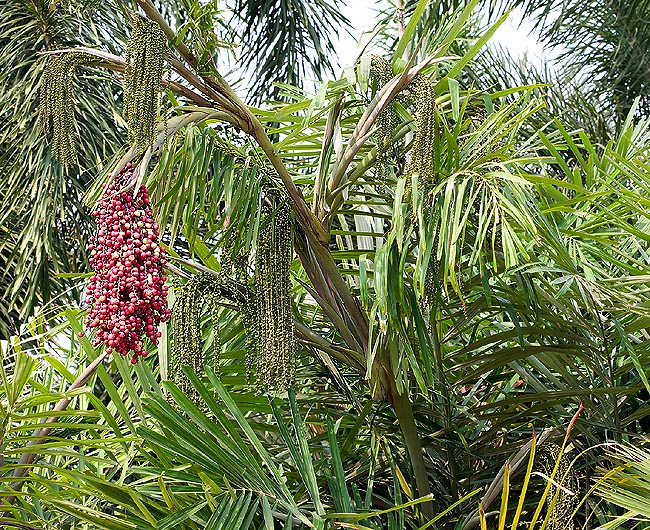Family : Arecaceae

Text © Pietro Puccio

English translation by Mario Beltramini

The Arenga microcarpa is a 7 m palm, very ornamental, for the tropical gardens © Giuseppe Mazza
This plant is native to Indonesia (Papua) and Papua New Guinea, where it is frequently present in the humid forests at low altitudes along the water streams.
The name of the genus, Arenga, comes from the Malaysian ‘areng’, referred to the Arenga pinnata; the name of the species is the combination of the Greek words “mikrόs”= small and “karpόs”= fruit, with obvious reference.
Common names: aren sagu, arrack palm, small-fruited areng palm, toddy palm, wild sagu (English); sagu-miúdo (Portuguese) .
Arenga microcarpa Becc. (1889) is a monoecious plant, monocarpic (bearing fruit only one time during its existence), moderately caespitose, with stems of 10-15 cm of diameter, tall up to about 7 m; in the part free of leaves, the stems are dark green and from them stand out the rings, mark of the leaves junctions, about 2 cm tall and distant about 40 cm one from the other.
The leaves, on a 1-1,5 m long petiole, are pinnate, about 3 m long, with the about 0,7 m long foliar base partly surrounding the stem, of green colour with scattered dark scales and blackish fibrous margins. The pinnulae, 30-70 per side and 0,4-0,8 m long, are linear with rounded or indented apex, of dark green colour on the upper side and covered by a grey-green thin tomentum on the lower one, and regularly distributed along the rachis, except the base where they are irregularly grouped and point towards different directions.
The about 1,5 m long inflorescences, develop from the above downwards and have male flowers of orange-yellow colour whilst the female flowers are lemon-yellow. The fruits are globose, 1,5-2 cm of diameter, red when ripe and contain 1 to 3 seeds; the pulp is much irritant due to the presence of calcium oxalate crystals and it is therefore to be carefully handled, wearing gloves if possible.
It reproduces by division and by seed which germinates in 2-5 months or more; in order to try to accelerate the germination, the seeds, once cleaned from the residuals of the pulp, following the aforementioned precautions, are to be dipped in water for 5-6 days, taking care to renew the water every day, for avoiding the proliferation of pathogenic micro-organisms. At the beginning the growth is slow, then it gets faster proceeding in a particular manner, as only 1 to 4 stems grow up quickly, surrounded by the others which remain low; when one dies after having completed the maturation of the stems, it is replaced by one of the tuft which gets the upper hand on the others.
Although not much cultivated outside from the origin zones, it is a species of great ornamental and landscape value, cultivable in full sun or in slight shade in tropical and subtropical climate zones, and, marginally, in the warm temperate, as it bears for short time temperatures as low as about -3 °C, even if with damage to the foliage. It may be utilized as isolated specimen, in wide gardens, as well as hedge. Like the others Arenga, the marrow is utilized by the natives for its high content in carbohydrates (sago), and the young buds are eaten cooked as vegetables.
Synonyms: Arenga gracilicaulis F.M.Bailey (1898); Didymosperma humile Lauterb. & K.Schum. (1900); Didymosperma microcarpum (Becc.) Warb. ex K.Schum. & Lauterb. (1900); Didymosperma novoguineense Warb. ex K.Schum. & Lauterb. (1900).
→ For general notions about ARECACEAE please click here.
